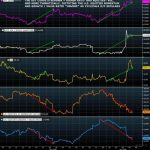Workers have jobs. The headline unemployment rate at 5.1% proves it, right? Yet the percentage of working-aged folks in the labor force at 62.6% represents the lowest employment rate since the late 1970s. Equally troubling? Wages/salaries rose a mere 0.2% in the second quarter. That was the smallest increase since data on wages have been kept. In fact, when adjusted for inflation, median household income has actually dropped since the Great Recession ended in June of 2009, from roughly $55,000 to approximately $53,650 today.
The economy is expanding, though. And things cannot be that terrible when the economy is growing, right? Unfortunately, the pace of growth has remained at the same fragile 2.0% for six years. The best that Warren Buffett could say about the U.S. economic situation was, “Not bad.” Keep in mind, the global economy is decelerating at a rapid clip with scores of influential developed and emerging nations fending off recessions. Meanwhile, the Organization of Economic Cooperation & Development (OECD) anticipates that the global slowdown will continue throughout the rest of 2015 and into 2016.
Maybe the U.S. is an economic island that is unaffected by trouble around the world. After all, Jim Cramer might tell you that our consumer-oriented economy is relatively independent, while simultaneously begging the Federal Reserve to declare 2015 a rate-hike-free zone. Or maybe the increasing trade deficit as a result of weaker exports will drag on the domestic expansion. (Note: The World Trade Organization explained that trade growth has averaged only 3% a year since 2010, compared with 6% annually from 1983 to 2008).) Or perhaps the significant declines in foreign sales and foreign profitability will be more difficult for U.S.-based corporations to mask when reporting 3rd quarter revenue and earnings.
The incongruence doesn’t stop at the doorstep of employment or the broader economy. Consider the wonderful news on homebuilder confidence. The National Association of Homebuilders (NAHB) has a monthly sentiment index that hit 62 – far above the positive-negative demarcation line of 50. The enthusiasm has not been this high since the end of 2005, when real estate sales and mortgages first began disintegrating in earnest. Perhaps ironically, existing home sales today are a fraction of what they were at the tail end of 2005, while mortgage applications are far from their peaks in 2012 and 2013; mortgage applications have been relatively flat since 2013.

















Leave A Comment